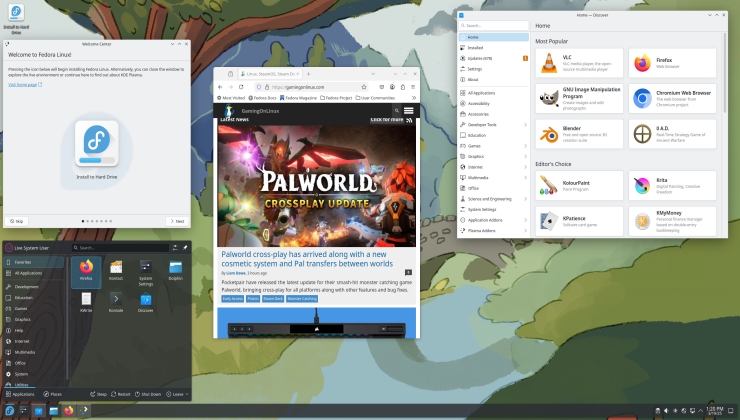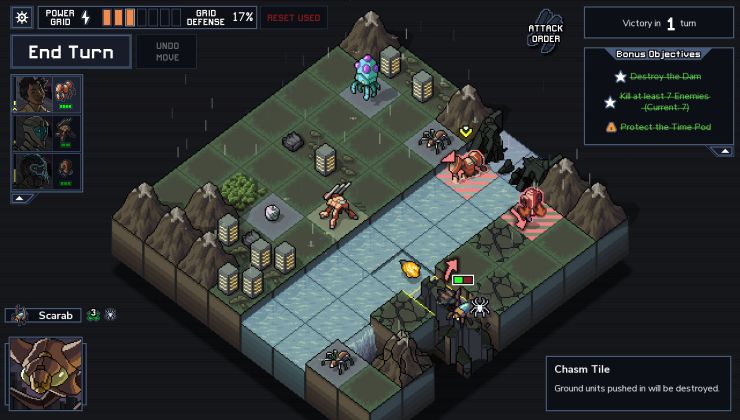Elecrow sent over a review unit of their new CrowView Note, a portable all-in-one monitor and keyboard that you can use to turn various devices into a proper workstation.
There's a growing list of companies that make these, and this is the first one I've been able to actually get my hands on to try and I have to admit — I'm pretty impressed. That said, to be clear this is not a general device for everyone, it's a specialised device to fill a specific need you may have.
It looks exactly like a laptop but appearances are deceiving. You use it via an external system that could be: an Android phone, a Steam Deck or other handheld, console, a Raspberry Pi and anything else that can connect via USB-C or Mini HDMI. In other words it's a laptop without a brain to make it think, so — a Lapdock? Some of you may know of it from others like the NexDock, various models from UPERFECT and so on. This is a more budget-friendly option though, for those of you who want something that works well but doesn't have a high price-tag.
For my testing, I decided on the kind-of obvious thing. I turned my Steam Deck OLED into my workstation this week. I've been wanting to do this for ages, to use the Steam Deck as a desktop properly too and this seemed like the perfect opportunity. However, this article is to really just go over the CrowView Note. Using the Steam Deck for it is a happy bonus. The fun news, is that it connects up to the SteamOS-powered Steam Deck without a fuss. Although, it was a nice test for which of my USB-C cables are junk (turns out, a lot). Plug it in, and KDE Plasma pops up to ask how you wish to use the display and away you go. That's it. Not sure what anyone is really expecting there though, it's a fancy display, hub and keyboard all in one. It would be odd if it wasn't plug and play which it very much is.
In terms of look, style and quality it really does just look like a pretty standard laptop. Nothing fancy there. It feels a lot like many lower-end laptops do, for better or worse. Plastic and clearly not high-end, but it's not trying to be. It's perfectly functional, looks okay and for its purpose, you don't need any more than that. All the ports worked fine and were all lined up correctly, so I had no problems using it for lengthy periods of time.
The keyboard being the US layout was initially confusing being in the UK, but that's such a minor point. The keyboard is pretty standard too, it feels okay to type on but nothing special, and certainly no worse than most cheap laptops. Complete with quick function keys to adjust volume, brightness, media playback and to see the current battery level. The trackpad is just fine too and decently sized, with multi-touch support to scroll around along with hidden left/right buttons at the bottom. The touchpad appears to be detected as a mouse, no touchpad settings available in KDE Plasma for it.
It comes with a few helpful adapter bridge connectors too for plugging into a Raspberry Pi, Jetson Nano and other similar single-board PCs. Nice little extra to see included.
The unit does have an OSD as well that allows you to adjust various display settings which is also quite useful to get it to whatever comfort level you need to work with:
One slight let-down here is that there's no light indicator for when the unit is fully charged. It has one on the top that's lit up white when it's turned on, and a small red light by the DC connector when it's charging, but nothing to indicate fully charged on the review unit. I spoke to Elecrow about this and they said that the complete units sent out will "add a charging status indicator" so that's great.
The battery life on it is okay, nothing particularly special there. You'll get somewhere between 1-2 hours on a full charge (Elecrow said) depending on what you're doing. With my Steam Deck OLED plugged in, with the display on the CrowView Note set to 90/100 and music playing from the built-in speakers at 20/100 volume it managed a good 2 hours 40 minutes while constantly working away.
With a price of $169 outside of the Kickstarter (early bird on Kickstarter starts $129), to me that actually seems properly reasonable for what you get, especially compared with the competition.
So what do you actually get here? A 14" 1080p IPS 100% sRGB screen that's nicely bright for general work and play, a 5000mAh battery, with a full keyboard and trackpad, 2x 2W speakers, along with:
Left Side:
- USB-A
- Mini HDMI
- USB-C Power Supply (PD 5V/5A Output) - no video in
Right Side:
- DC 3.5mm Power Supply (12V/4A Input) - comes with a power plug
- USB-A
- Headphone Jack
- USB-C (5V/3A Output) - video in
I think if I'm ever going to be using an extra device be it my RPi, Steam Deck or otherwise for a mixture of work and play — the CrowView Note is what I'm going to be using. It's going to find a permanent place on my living room table. And heck, paired up with a Steam Deck, it's more powerful and useful than my actual laptop and only a little bit less portable together.
Perhaps next time you're looking for some sort of dock, or a hub or just something to pair up with other devices, you may want to take a look at the CrowView Note. If you have multiple devices you switch around a fair bit, this could easily be a great addition to your tech shelf.
The CrowView Note is crowdfunding on Kickstarter with the goal met. You can also see more on their website. Shipping should begin in October 2024.
Inputting the video signal to a laptop as if it were from an external webcam is an intriguing idea. I'd love to know how to do it.
It is basically just a portable capture card, and some of them are about the size of a USB flash/thumb drive. The cheapest ones cost roughly 10 USD in the US.
I am uncertain if there are rules related to naming specific devices on this website, so anyone can correct me if there is a rule about it (and I will edit this post)... but Genki (and its Shadowcast line of products) is the only company I know of that sells ones compatible with ChromeOS, because it has a browser "app¨ to allow streaming to a browser. So it is the one I use. The cheapest one retails I think for... 30 USD in the US? It is the one I use, but its successor I understand to have lower latency, higher resolution, etc (but with reduced compatibility). So you could just look up Genki Shadowcast (original, 2, or Pro), if only to look up videos showing the visual quality, latency, etc.
I just use guvcview to display it on my chromebook, and Barrier if I want to control the Steam Deck with my Chromebook keyboard.
Last edited by Noiram on 8 Sep 2024 at 7:39 pm UTC
Well, it's about time someone invented it...
There are alternatives already, like: https://www.uperfectmonitor.com It is just something that I am considering to buy for my galaxy tablet to use on the go as a laptop. But I never tought I can also hook up my Steam Deck when I am remote. It's a good ideea.
Well, it's about time someone invented it...
There are alternatives already, like: https://www.uperfectmonitor.com It is just something that I am considering to buy for my galaxy tablet to use on the go as a laptop. But I never tought I can also hook up my Steam Deck when I am remote. It's a good ideea.
The big thing missing from most external laptop monitors is the keyboard. Ive actually been looking for something like the crowview note for a LONG time, as I have a bunch of misc headless PCs acting as servers, and whenever I have to set up a new one or change BIOS settings on an existing one, or if networking breaks so ssh doesnt work, I have to lug over an external monitor and keyboard. This solves that really, really nicely. (the only way they could make it better would be with displayport and VGA ports, but it doesnt look like the laptop chassis they have would allow that.)
Looks like it's detected as a mouse, Plasma settings also blanks out touchpad settings. Although I did just discover three fingers on the pad will also bring up the alt+tab switcher.
What a pity. It seems to be a nice device otherwise.
Inputting the video signal to a laptop as if it were from an external webcam is an intriguing idea. I'd love to know how to do it.
Steam Deck has no UDC, so it won't work there. You should be able to do it on phones though.
Last edited by dos on 5 Oct 2024 at 11:22 am UTC










 How to set, change and reset your SteamOS / Steam Deck desktop sudo password
How to set, change and reset your SteamOS / Steam Deck desktop sudo password How to set up Decky Loader on Steam Deck / SteamOS for easy plugins
How to set up Decky Loader on Steam Deck / SteamOS for easy plugins
See more from me